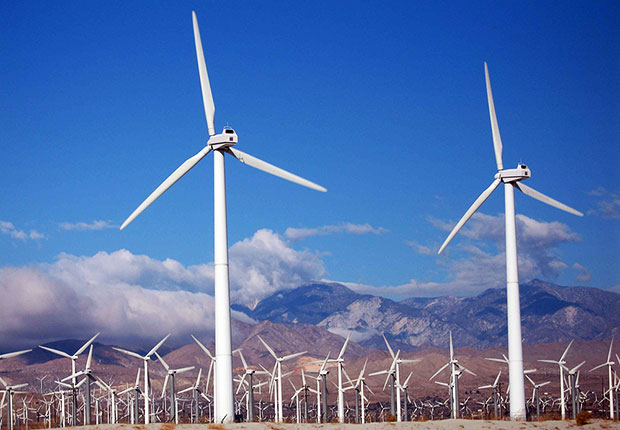Predicting the power output of wind farms has been challenging, but it’s becoming less so with the use of machine learning.
Google and British artificial intelligence company DeepMind have been using ML algorithms to improve predictions of the wind power output at Google’s wind farms in the Midwest, according to a post coauthored by DeepMind Program Manager Sims Witherspoon and Google Carbon Free Energy Program Lead Will Fadrhonc.
The farms, which produce 700 megawatts of electricity — enough to power a medium-sized city — use the algorithms to predict wind power output 36 hours ahead of generation.
With those predictions, wind farmers can make hourly commitments to the power grid a full day in advance. That’s important, because energy sources that can be scheduled for delivery to the power grid are valued higher than those that can’t.
The value of the energy produced by the wind farms has increased 20 percent compared to when energy output was less predictable, according to the companies.
“If you’re not so certain about what you’re going to produce, you’ll probably discount your output and not sell as much,” said Gary Cook, a senior energy analyst at Greenpeace in Washington, D.C.
“Google can’t generate more wind, but with more reliable data, the grid operator can have more certainty about what’s being generated and can manage accordingly,” he told TechNewsWorld.
Meeting Demand
Grid providers try to match user demand to the amount of electricity they produce. If they receive power from unpredictable sources, like wind, it makes managing demand more difficult for them.
It also adds to their cost of operations. Since they don’t know when they’re going to get electricity from unpredictable sources, they need to have alternative “instant” energy sources online — such as batteries — to meet demand when they’re not getting any juice from the unpredictable sources.
“If they can get more advanced warning about the power they’re going to receive from the wind farm, that reduces the challenges in meeting demand, and they have to call upon less of this instant generation capacity,” explained Petter Karal, CEO of Seatower, an offshore wind company based in Oslo, Norway.
“That makes wind power more valuable to the grid,” he told TechNewsWorld.
“If wind power is more predictable and easier to integrate into the grid, then it will become more competitive for future investment decisions regarding generation capacity,” Karal added.
Better Models
Alternative energy sources can have an impact on global climate change.
“When renewable energy becomes more competitive than fossil fuels, you will use more renewable energy and less fossil fuels,” Karal said.
Wind models have been getting better all the time, Greenpeace’s Cook noted. “What you have here with the collaboration of Google and DeepMind is the taking of a lot of data and crunching it down so you can provide with greater certainty what a location is likely to generate.”
If the data analysis had to be done by humans, the data set would have to be scaled down.
“With machine learning, you can take a huge data set, dump it in there, and get more granular and more confident about what the outcome would be,” Cook said. “Machine Learning can recognize patterns that would be super time-consuming for humans to find.”
ML-Aided Maintenance
Artificial Intelligence has the potential to increase the value of alternative energy, observed Karal.
“There will be many applications,” he said. “Some of them we can envision now, but most of them will be invented over time as machine learning becomes more generic and more easily applicable.”
One current application of ML is maintenance of infrastructure, like offshore turbines.
“Maintenance of offshore wind turbines is a huge thing, because it’s a big job to go 20 miles offshore and climb a 300- or 400-foot tower in the middle of the sea. That’s resource-intensive,” Karal explained.
“If you can have an AI-assisted prediction of when service is required — and when the service technician is there, predict further maintenance — that could be very valuable,” he added.
Strengthening Wind’s Business Case
Although it isn’t possible to eliminate the variability of the wind, machine learning can make wind power more predictable and valuable.
“Our hope is that this kind of machine learning approach can strengthen the business case for wind power and drive further adoption of carbon-free energy on electric grids worldwide,” Witherspoon and Fadrhonc wrote.
“Researchers and practitioners across the energy industry are developing novel ideas for how society can make the most of variable power sources like solar and wind. We’re eager to join them in exploring general availability of these cloud-based machine learning strategies,” they added.
“Google recently achieved 100 percent renewable energy purchasing and is now striving to source carbon-free energy on a 24×7 basis,” noted Witherspoon and Fadrhonc. “The partnership with DeepMind to make wind power more predictable and valuable is a concrete step toward that aspiration.”
Duplicitous Behavior?
Despite Google’s commitment to a green future, it seems to be hedging its bets, suggested Brian Merchant in a Gizmodo article.
Like Amazon and Microsoft, Google cut deals worth billions of dollars to provide automation, cloud and AI services to the world’s biggest oil companies, Merchant wrote.
The deals essentially automate the climate crisis, he maintained, through deals that are geared toward streamlining and improving oil and gas extraction operations.
Through a series of deals, Merchant pointed out, Google can use its machine learning to find more oil reserves both above and below the seas, its data services to streamline and automate oilfield operations, and its tools to help oil companies find ways to trim costs and compete with clean energy upstarts.























































